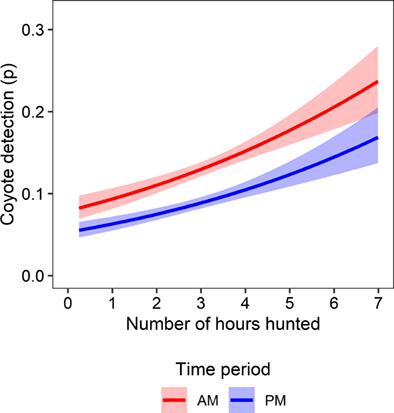当前位置:
X-MOL 学术
›
Ecol. Res.
›
论文详情
Our official English website, www.x-mol.net, welcomes your feedback! (Note: you will need to create a separate account there.)
Mismatched spatial scales can limit the utility of citizen science data for estimating wildlife‐habitat relationships
Ecological Research ( IF 2 ) Pub Date : 2020-09-21 , DOI: 10.1111/1440-1703.12173 Javan M. Bauder 1 , Alyson M. Cervantes 2 , Alexandra C. Avrin 2 , Laura S. Whipple 2 , Morgan J. Farmer 3 , Craig A. Miller 1 , Thomas J. Benson 1, 2 , Kirk W. Stodola 1 , Maximilian L. Allen 1, 2
Ecological Research ( IF 2 ) Pub Date : 2020-09-21 , DOI: 10.1111/1440-1703.12173 Javan M. Bauder 1 , Alyson M. Cervantes 2 , Alexandra C. Avrin 2 , Laura S. Whipple 2 , Morgan J. Farmer 3 , Craig A. Miller 1 , Thomas J. Benson 1, 2 , Kirk W. Stodola 1 , Maximilian L. Allen 1, 2
Affiliation

|
Funding information Federal Aid in Wildlife Restoration; Illinois Natural History Survey Abstract While most carnivore populations are declining worldwide, some species are successfully living in human-modified landscapes. For example, coyotes (Canis latrans) have expanded their range across North America and into many urban areas making it important to understand factors influencing broad-scale patterns of occurrence. We used citizen science data in the form of coyote observations by archery deer hunters from throughout the state of Illinois to evaluate factors affecting coyote detection and occupancy. Our statewide participant-level occupancy estimate (0.63) was 58% greater than our naïve occupancy estimate (0.40) while detection probability was <0.25, highlighting the importance of using modeling frameworks that account for imperfect detection when modeling occupancy of cryptic species with low detection rates. Time period (AM/PM) had the largest effect on detection of coyotes, with detections greater in the AM. The number of hours hunted (analogous to effort) also impacted coyote detection, with more hours hunted increasing coyote detections. In contrast, none of the landscape covariates examined had strong effects on coyote occupancy. While coyote ubiquity and generalist habitat use may at least partially explain our results, we suspect it also is because the landscape covariates were measured at the county level, as more precise participant location data were unavailable, whereas participants effectively surveyed a much smaller area. Since scale affects the strength and direction of species-habitat relationships, this scale mismatch is likely an important limitation when using many sources of citizen scientist observations to infer species-habitat relationships for widespread generalist species when precise participant location data are unavailable.
中文翻译:

不匹配的空间尺度会限制公民科学数据用于估计野生动物栖息地关系的效用
资助信息 联邦野生动物恢复援助;伊利诺伊州自然历史调查摘要 虽然世界范围内大多数食肉动物种群都在下降,但一些物种成功地生活在人类改造的景观中。例如,土狼(Canis latrans)已经将它们的活动范围扩大到北美和许多城市地区,因此了解影响广泛发生模式的因素非常重要。我们使用来自伊利诺伊州各地的射箭猎鹿者以土狼观察的形式使用公民科学数据来评估影响土狼检测和占用的因素。我们全州参与者级别的入住率估计 (0.63) 比我们的朴素入住率估计 (0.40) 高 58%,而检测概率 <0.25,强调在对低检测率的隐蔽物种的占用进行建模时,使用可解释不完美检测的建模框架的重要性。时间段 (AM/PM) 对土狼的检测影响最大,AM 中的检测量更大。狩猎的小时数(类似于努力)也影响了土狼的检测,狩猎的时间越长,土狼的检测就越多。相比之下,所检查的景观协变量都没有对土狼的占有率产生强烈影响。虽然土狼无处不在和多才多艺的栖息地使用至少可以部分解释我们的结果,但我们怀疑这也是因为景观协变量是在县级测量的,因为无法获得更精确的参与者位置数据,而参与者有效地调查了一个小得多的区域。
更新日期:2020-09-21
中文翻译:

不匹配的空间尺度会限制公民科学数据用于估计野生动物栖息地关系的效用
资助信息 联邦野生动物恢复援助;伊利诺伊州自然历史调查摘要 虽然世界范围内大多数食肉动物种群都在下降,但一些物种成功地生活在人类改造的景观中。例如,土狼(Canis latrans)已经将它们的活动范围扩大到北美和许多城市地区,因此了解影响广泛发生模式的因素非常重要。我们使用来自伊利诺伊州各地的射箭猎鹿者以土狼观察的形式使用公民科学数据来评估影响土狼检测和占用的因素。我们全州参与者级别的入住率估计 (0.63) 比我们的朴素入住率估计 (0.40) 高 58%,而检测概率 <0.25,强调在对低检测率的隐蔽物种的占用进行建模时,使用可解释不完美检测的建模框架的重要性。时间段 (AM/PM) 对土狼的检测影响最大,AM 中的检测量更大。狩猎的小时数(类似于努力)也影响了土狼的检测,狩猎的时间越长,土狼的检测就越多。相比之下,所检查的景观协变量都没有对土狼的占有率产生强烈影响。虽然土狼无处不在和多才多艺的栖息地使用至少可以部分解释我们的结果,但我们怀疑这也是因为景观协变量是在县级测量的,因为无法获得更精确的参与者位置数据,而参与者有效地调查了一个小得多的区域。



























 京公网安备 11010802027423号
京公网安备 11010802027423号